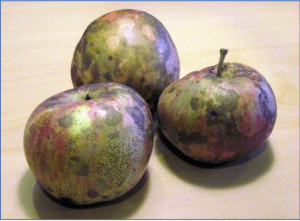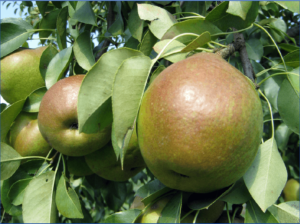Tipsheet: Transitioning to Organic Management of Orchards
By Guy Ames, ATTRA
Organic certification verifies that fruit is produced according to United States Department of Agriculture (USDA) organic standards. See www.ams.usda.gov/nop for details of the standards. In general, the regulations make several requirements of certified organic fruit:
- Produced without genetic engineering, ionizing radiation, or sewage sludge
- Managed in a manner that conserves natural resources and biodiversity
- Raised per the National List of Allowed and Prohibited Substances (National List)
- Overseen by a USDA-authorized certifying agent
All National Organic Program regulations for crops apply to tree fruits. The only regulation specifically pertaining to orchards is 7 CFR §205.204(a)(4):
“Nonorganically produced planting stock to be used to produce a perennial crop may be sold, labeled, or represented as organically produced only after the planting stock has been maintained under a system of organic management for a period of no less than 1 year…”
Basic Principles
Numerous pests and diseases, coupled with the high cosmetic standards of the market, make commercial organic tree fruit production difficult, especially in the East. The relative permanence of an orchard provides ecological stability, including opportunities for soil conservation and soil building. On the other hand, that relative permanence can allow the build-up of some pests, diseases and weeds since crop rotation is eliminated as a pest-management tool for all but the cover crop in the aisles.
Transitioning to Organic Disease Control in Orchards
Disease-resistant cultivars should be the foundation of an organic disease management program. However, many popular commercial cultivars have little or no genetic resistance to diseases. Furthermore, only a few cultivars have across-the-board resistance to all the major diseases in an area, and these cultivars are generally not well known to consumers.
- Sulfur and copper-type fungicides/bactericides are the mainstays of organic disease management; however, they are problematic, especially in the humid East where they must be on plant surfaces before a rain to pr vent infection, but can easily be washed off by rain.
- Agricultural-grade antibiotics are no longer allowed in organic production for fire blight control in apples and pears.
- New-generation disease management tools, like microbial antagonists of certain pathogens, are becoming available, but are also problematic, especially in the East, where disease pressure is higher.
- Cultural techniques for managing tree fruit diseases mostly involve opening up the trees with pruning and training to promote rapid drying of plant surfaces after rain. These techniques are generally not adequate by themselves to control diseases, but can augment other approaches.
- Flail mowing of prunings or removal of prunings from the orchard removes an important source of disease inoculum.
Transitioning to Organic Insect and Mite Control in Orchards
- Several key pests, such as codling moth, plum curculio (only east of the Rockies), cherry fruit fly, and stink bugs can render the better part of a fruit crop unsaleable if ignored. Consumers, in general, are not accepting of insect damage on, or especially in, a fruit. Because of the many pests that attack tree fruits and the low tolerance for damage, the grower needs to understand the life cycles of the pests and the points at which they are vulnerable to management.
- “Particle film technology” using a finely pulverized kaolin clay product, Surround™, has revolutionized organic insect management in tree fruits in the past two decades, making organic control of stubborn pests like plum curculio possible. Surround™ controls most tree fruit pests if fruit and leaves are adequately covered. Three problems bear mentioning: 1) Surround™ does weather off with time and rain, so multiple applications can be necessary, 2) if it doesn’t weather off or get washed off in a brusher/washer, residues will remain on fruit, 3) Surround™ readily precipitates out of solution in the spray tank, so the tank must be constantly agitated while applying.
- At least one botanical insecticide, neem, and several relatively new microbials—e.g., Spinosad™ and Beauvaria bassiana—can be effective against particular pests.
- Pheromone disruption systems for specific pests, like codling moth and oriental fruit moth, are effective.
- Conservation of habitat and food sources (e.g., certain wildflowers) encourages beneficial insects and other organisms and can augment insect and mite control in orchards.
Transitioning to Organic Weed Management in Orchards

Sooty blotch and flyspeck are serious cosmetic disorders on apples in the East. Photo: Robyn Metzger, NCAT
- Crop rotation is impossible in an orchard situation. Pernicious weeds, like bermudagrass in the Almond trees in bloom. South and quackgrass in the North, are hard to control organically, especially if you can’t rotate to a smother crop. However, a thick cover crop in the aisles can keep weeds like bermudagrass from getting started and moving under the tree canopy. Also, the aisles can be planted (and rotated) to various cover crops for advantages such as providing mulch material, enhancing pest control, and contributing to tree nutrition.
- Mulch can be part of a good weed management strategy but can also encourage pests like mice and voles. Wood chip mulches don’t harbor rodents and have performed well in research trials.
- Precision, tractor-mounted mechanical weeders that prevent trunk damage are effective but not in mulched trees.
- Flame weeding and organic herbicides can be effective where weeds are short and applications are repeated, but the multiple applications necessary can get costly. No systemic herbicides are available for organic production, making control of some weeds very difficult.
Organic Fertility in Orchards
- Liming should occur prior to planting and in accordance with soil tests.
- Foliar analysis coupled with soil tests will give the best indication of tree nutrient status.
- Pre-plant cover crops are advised for both fertility and weed control.
- Nutrient contribution of cover crops in the aisles between rows appears to be small and should not be relied upon alone for fertility. (However, cover crops have other beneficial impacts on soil and the orchard ecosystem, such as minimizing erosion, improving water infiltration, and providing habitat for beneficial insects.)
- In general, fruit trees are not heavy feeders, and their needs are often met by decomposing mulches, com- post applications, and/or organic foliar feeding. In fact, too much nitrogen can induce problems like fire blight and soft fruit.
- With education and experience, most fruit growers will learn to recognize the symptoms of nutrient problems: inadequate growth of shoots, chlorotic color of leaves, fruit disorders (e.g., apple measles), etc.
Market Considerations for Organic Fruit
Demand for organic fruit is usually high, and the premium for organically certified fruit is usually correspondingly high. In the West, brokers, some specializing in organic fruit, handle most of the fruit; much of it is headed to the East where organic production of tree fruits is comparatively small. In the East, the small amount of organic fruit produced is most often retailed directly by the farmer, but there is beginning to be some distribution through food hubs.
In the East, growers will often have to educate clientele about why their fruit looks the way it does. Direct contact with the end consumer is usually necessary for this education. Growers, especially in the East, should have a marketing plan that includes value-added products like cider, sauce, jams, and jellies to provide a use for damaged and cosmetically inferior fruit.
Further Resources
ATTRA’s series on organic fruit production, including publications on organic production of cherries, apples, peaches, plums, and pears. Access at www.attra.ncat.org or call 1-800-346-9140.
Peck, Gregory, Ian Merwin, et al. 2009. A Growers Guide to Organic Apples. NYS IPM Publication No. 223. Cornell University. Ithaca, NY. http://nysipm.cornell.edu/organic_guide/apples.pdf
WSU Tree Fruit Research & Extension Center. Organic & Integrated Tree Fruit Production.
www.tfrec.wsu.edu/pages/organic/Organic_Production
University of California Small Farm Program. http://sfp.ucdavis.edu/
USDA Organic Regulations 7 CFR 205: www.ams.usda.gov/nop
USDA National Organic Program Handbook: www.ams.usda.gov/NOPProgramHandbook
NOP 5029 – Guidance: Seeds, Annual Seedlings and Planting Stock in Organic Crop Production.
USDA National List of Allowed and Prohibited Substances: www.ams.usda.gov/NOPNationalList
This article was developed with support from U.S. Department of Agriculture’s Agricultural Marketing Service, National Organic Program
Produced by the National Center for Appropriate Technology
www.ncat.org • 1-800-275-6228 (1-800-ASK-NCAT)
(Parent organization to the ATTRA Project, www.attra.ncat.org)


